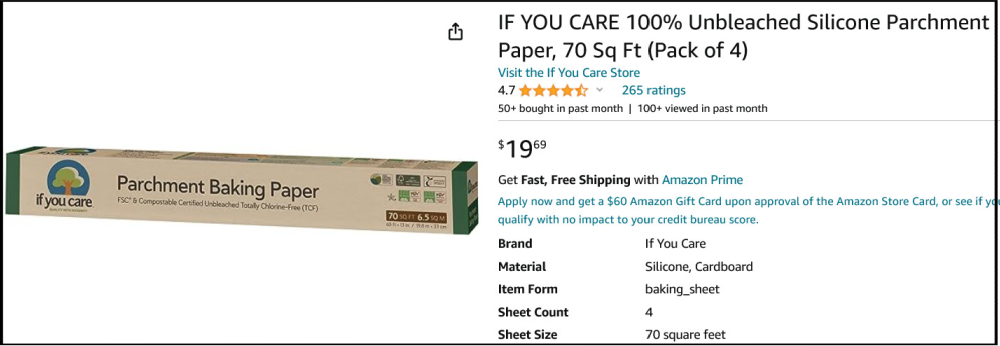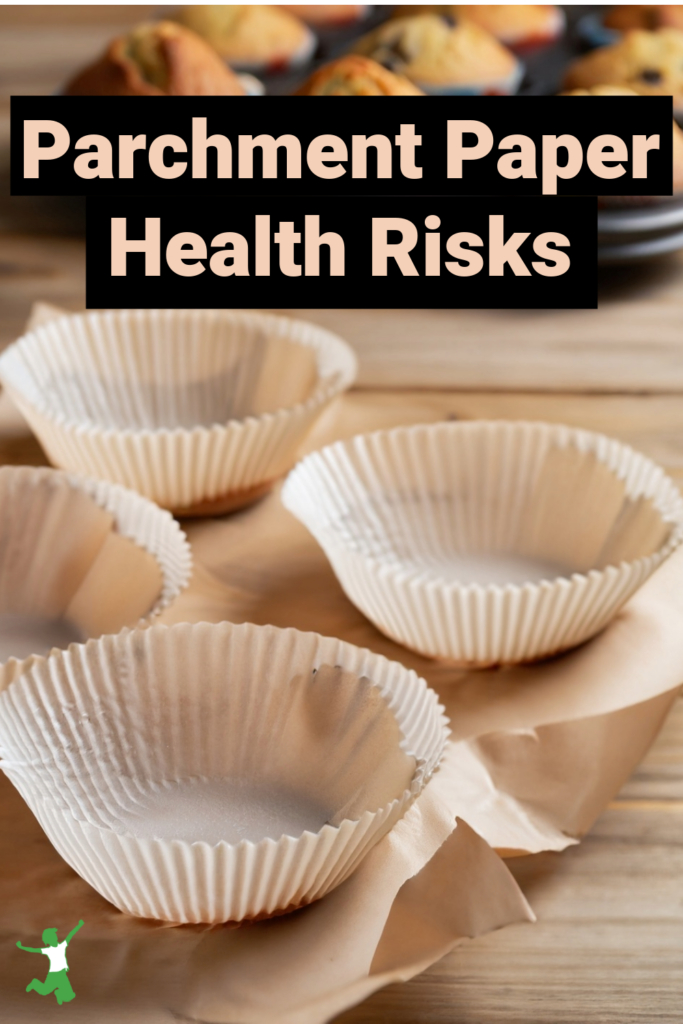The major health risks of unbleached and PFAS-free parchment paper products and why Grandma’s alternative method is the best approach after all.

I’ve made a major upgrade over the past few years to my baking routine, and I wanted to share this important change with all of you!
I no longer use parchment paper or baking cups of any size or brand in my baking routine at all.
Those of you who have been reading this blog for a long time will remember that I used to use it to cover my aluminum bakeware to protect the food from heavy metal exposure.
Little did I know at the time that I was swapping one set of toxins for another!
When I suggest ditching ALL brands of parchment paper, this includes unbleached brands such as “If You Care” which consistently receives high accolades for safety and has many “green” certifications such as compostable and biodegradable as well as the coveted EU Ecolabel. (1)
I’ve warned before that “green” products are not necessarily healthy.
Unbleached parchment paper of all sizes and varieties is a prime example!
Unbleached Parchment Paper Isn’t Safe (even if PFAS-free)
While bleached parchment paper is quite obviously best avoided due to the potential for chlorine residues from the bleaching process, the danger from unbleached varieties is more stealthy.
While marketed as “chlorine-free”, unbleached baking paper is actually coated with silicone.
What exactly is silicone anyway? Is it the same thing as silicon, the natural element with the chemical symbol Si and atomic number 14?
They are far from the same thing, as it turns out!

Synthetic Rubber
According to Scientific American, silicone is a synthetic rubber. Its chemical name is siloxane.
Silicone [siloxane], a synthetic rubber made of bonded silicon (a natural element abundant in sand and rock) and oxygen, is increasingly filling this niche. The flexible yet strong material, which has proven popular in muffin pans, cupcake liners, spatulas and other utensils, can go from freezer to oven (up to 428 degrees Fahrenheit), is non-stick and stain-resistant, and unlike conventional cookware, comes in a range of bright and cheery colors. (2)
Sounds so safe, doesn’t it?
Manufacturers know that conflating an artificial material with a natural one by making their names virtually identical makes it so easy to confuse the public!
While manufacturers insist that silicone is safe and inert, I beg to differ.
Silicone Leaches into Food
Studies have shown that silicone can migrate into food at normal cooking and baking temperatures.
Even though silicone elastomers demonstrate a high degree of thermal stability and excellent resistance to aging, high temperatures lead to depolymerization of the elastomer, with subsequent volatilization and migration [into food] of certain substances. (3)
Inflammatory Effects
In addition, medical devices that contain silicone implanted in the body have shown deleterious health effects.
Thus, it would seem that silicone that is ingested may very well pose health risks. This would include an inflammatory response at minimum. (4)
In fact, it seems to me that the FDA has completely dropped the ball on investigating whether siloxanes are as “inert” as claimed especially when it comes to their widespread use in silicone baking molds and kitchenware.
No follow-up studies have ever been done since 1979 to assess this important question with regard to the implications for long-term health. (5)
Endocrine Disruption, Tumors, Cancer
While the FDA hasn’t done much to ensure silicone is safe, the EU has.
The European Union classifies siloxanes as a Class 1 endocrine disruptor. (6)
In addition, silicone, aka siloxanes, can cause uterine tumors and reproductive issues, possibly even leading to infertility. (7)
The final nail in the coffin is that siloxanes are also a carcinogen and can cause liver damage. (8)
Unbleached parchment paper coated with siloxane doesn’t sound so inert and safe anymore, does it?
No wonder they picked the euphemism “silicone” for this toxic substance!
How to Ditch Parchment Paper for GOOD
Since ditching unbleached parchment paper several years ago, I’ve been baking the old-fashioned way.
Just like my Grandma did! Turns out (for the umpteenth time), that she really DID know best!
I grease and flour muffin cups, pizza pans, and cookie sheets before adding the dough and placing it in the oven.
I am also now using stainless steel baking sheets and pans (this brand).
UPDATE: I recently found this safe brand of uncoated cooking parchment which works great for cookies and bread as well as steaming or broiling meat and veggies!
“Grease and Flour” Approach
There is no magic to greasing and flouring a baking surface.
Simply slather a thin film of healthy, high smokepoint fat on the surface of the pan(s) that will contact the food.
Then, sprinkle a bit of flour over the top. You can use your fingers to do this (a pinch of flour at a time). That’s what I do.
Or, you can use a small strainer.
The flour does not need to totally cover the greased portion of the pan, and you don’t need to mix it into the oil.
That’s all there is to it!
I use expeller-pressed “no taste” coconut oil and a dusting of homemade gluten-free sprouted flour blend for this task.
The good news is that this method works spectacularly well.
Your cupcakes will pop out of those muffin pans just as easily as a toxic unbleached baking cup.
Cookies will slide off the cookie sheet with a spatula quickly and 100% intact.
The downside is…
More Time, Bigger Mess
The extra step to grease and flour baking pans and cookie sheets definitely takes more time.
In addition, it can be a bit messy at first until you get the hang of it.
Soaking or even elbow grease is sometimes necessary to get those muffin tins and cookie sheets clean too.
Even still, I feel so much better doing it this way.
I’ve taken great care to source the ingredients properly, it would be such a shame to wreck the dish with a toxic silicone residue from a greenwashed “chlorine and PFAS-free” product!
What About Unheated Uses?
While the danger of using unbleached, silicone-coated parchment paper for baking is cut and dry, what about uses at room or refrigerated temperature?
The health issues from using unbleached parchment paper are markedly less for this scenario.
However, after careful thought, I’ve chosen not to use it at all. The research coming out about the dangers of siloxanes is just too concerning!
The potential for residue in the food is still present even at room temperature or in the refrigerator/freezer.
Silicone is not something I want in my body even in the tiniest amounts given that it is a persistent toxin in the environment.
Since there are safer products to wrap and store food, I felt most comfortable ditching any and all forms of unbleached parchment paper.
Have you realized the dangers of parchment paper to your long-term health? What steps have you taken to eliminate it from your baking routine?

(1) If You Care Certifications
(2) Silicone Tally: How Hazardous Is the New Post-Teflon Rubberized Cookware
(3) Heat stability and migration from silicone baking molds
(4, 5) Is Silicone a Plastic?
(6, 7) The Dirty Dozen: Siloxanes
(8) What are Siloxanes: Chemical Free Living








What are you using for muffin pans? Also, are you still recommending the parchment alternative linked on here for baking? Thanks so much. I currently will not make cupcakes or muffin because I do not have a proper pan.
I use Norpro stainless steel muffin pans. I’m not sure they make them anymore, but there are plenty of stainless steel muffin pans on the market. The patapar paper is great, but does not work very well for muffin pans. I recommend upgrading to stainless steel ones you can grease and flour the old fashioned way.
What’s the point of purchasing the patapar paper if you still have to grease to keep food from sticking? Save the money and grease the pan.
Yes, I agree. I do what Grandma did … grease and flour the pan. I just suggest the patapar paper for people who don’t want to scrub the pan afterward!
Thank you for the great info. I looked at butcher paper on Amazon and found many that are unbleached, uncoated, and unwaxed. Are these good options? Does it mean these options are silicone free?
I found the following review on Amazon for Patapa Paper:
By Rachel: 1 out of 5 stars Product has been bleached!
Reviewed in the United States on December 3, 2024
“Customer service told me the product has been bleached. I try to use unbleached products because they create dioxin which I don’t want to ingest! Sadly, still looking for an alternative to unbleached parchment paper which contains silicone…”
It seems to me that butcher paper would be a risk for catching fire in the oven. It is not designed to be heated.
Patapar paper is the only decent substitute I’ve found, otherwise, you can grease and flour your pans like Grandma did (best option by far).
Years ago when my children were young, I used to bake oatmeal cookies. Because I always found cleaning burnt on oil very hard to clean, I tried baking the cookies on stainless steel cookie sheets without putting anything at all on the cookie sheets. The baked cookies were always very easy to remove with a stainless steel spatula. After I was done baking cookies, I put some water in the cookie sheets (my cookie sheets had short sides), and within a short amount of time the cookie sheets were extremely easy to clean. I’m thinking the amount of oil in the cookie dough recipe made them not stick too much so this might not work for other cookie recipes. I never tried this method when I baked whole wheat bread in the 70’s and the 80’s, but I followed the suggestion from Magic Mill to coat the insides of the bread pan with lecithin and then sprinkle some flour on it. This worked like a charm; that is, the baked bread was very easy to remove, and the bread pan was very easy to clean after a little soaking. I haven’t read about using lecithin since the 80’s so I don’t know what I would think about that now!
Hi, thank you for your advice on the baking parchment, I have tried the grease and flour technique on a glass pirex loaf pan when baking ff bread, but it was disastrous, do you have any recommendations for helping the bread come out? (I thought of making buns instead, but the dough is too runny) Look forward to your reply, thank you
Letting it cool before removing it from the pan works well for me. It will stick quite a bit if it is still hot or even overly warm in the center. I also use a knife to loosen it around the edges before removal.